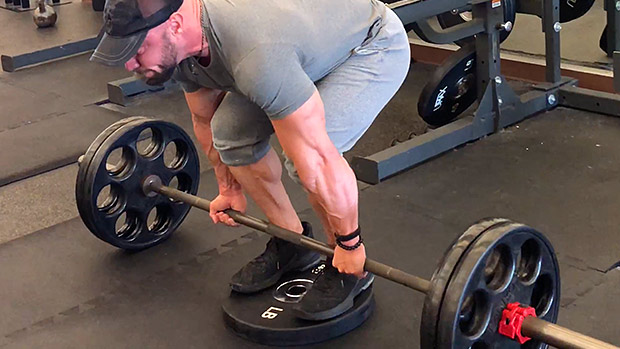Progressive overload is not the end-all and be-all of the training experience.
Don't misunderstand me, I don't think any program for strength or hypertrophy is truly complete without regarding the importance of methodically using increasingly heavier weights.
The problem comes when form, technique, and plain smarts are left by the wayside in the never-ending quest for more weight and more PRs. As such, it's time to view weight training differently.
When you only boil things down to how much weight is on the bar, you can put yourself in danger, and perhaps do permanent damage to your confidence when you don't continue to make linear improvements in your lifting numbers.
A change in perspective is in order. People need to consider progress from these points of view:
Range of motion
If you can perform the same exercise with the same weight, but cover a greater distance with that weight, then you've just done more total work AND you're progressing. In physics, work is measured as force x distance. A bigger range of motion (ROM) equals bigger gains.

Set up your deadlifts and split squats from a deficit position and you'll feel the added demands right away.
Rest Intervals
We often think about the performance when we're lifting a weight. What about the performance when we're not, i.e., between sets?
The amount of time it takes us to recover between sets needs to count for something. If we can perform the same task when we've rested for only two-thirds the amount of time, our muscles are getting better conditioned. It also opens up the door for more volume to be added to our workout.
Before you add any weight to the bar, cut the rest interval by 15 seconds. It's a great test to see if you really own the current poundage and are ready to take the next step upwards.
More reps
If you can do more reps with the same weight, you've made gains. After you just hit 405 for a triple, don't be so quick to try 415 for the same number of reps.
Instead, why not try to hit four reps with that 405? Or five reps? That's real progress. Don't worry, you're still strength training.
This sounds like it makes no sense, but just means making simple manipulations to your training to increase one particular gauge of measurement – your rate of perceived exertion (RPE).
You might be able to lift 300 pounds, but do you own it? Consider the following manipulations:
Adopt a pause
Coming to a full stop at the bottom of any eccentric rep kills any momentum or transfer of forces. It basically makes every single rep of every single lift "honest."
Starting with 60-70% of your typical max and doing paused sets of 3-5 seconds in the big lifts is a great way to start your percentage work with a clean slate and offers a new approach to true maxes.
Be aware, though, that using this method will quickly expose just how much you were letting your stretch reflex and the elasticity in your muscles assist your efforts. (Otherwise known as cheating your ass off.)
Get ready for an eye-opening experience. There are a couple of ways to do it. You can try a slow eccentric with a pause, as seen in the first video below, or a nearly eccentric-less rep style as seen in the second. Either way, lack of directional-change momentum is the key.
Slow It Down
If your max bench press was 300 pounds, chances are that trying to lift 305 would leave the bar pinned to your chest. But if someone HANDED you 305 at the TOP of the lift, it's likely that you could lower it slowly to your chest.
Obviously, we can lower more than we can lift, making eccentric strength the true testament to how much strength our muscles possess. Taking a page out of the books of Christian Thibaudeau and Joel Seedman, accentuating negative reps (really lowering the weight slowly) where possible will only spell out good things for training gains, and nine times out of ten, it won't take stacking on more plates to get the job done.
If eccentric tempos make you really feel like a rock star, try combining pauses and slow tempos together to get even more bang for your buck.

Power training is optimized when you can find the perfect intersection between loading and being able to accelerate that load (or build velocity).
Thanks to the name itself, "powerlifting" has misled many to believe that heavy single and double efforts are the primary or sole way of training to become more explosive, which isn't completely true.
You can get plenty of benefit from lifting heavy for power, but using a lighter weight and learning to explode with it is a step in the right direction; it requires channelling force into a bar (or into the floor). It's the reason the hang clean is such a highly regarded movement in many areas of competitive sports training.
It's all about the fast twitch muscle fibers and high threshold motor units getting some air time. Making them fire more efficiently can actually translate into a better quality big lift when things are later put to the test.
If you're not skilled at complex movements like the Olympic lifts, try getting explosive by way of some contrast sets. These require combining a basic movement pattern like a squat or deadlift with a bodyweight (or very lightly loaded) version of the same movement pattern:
| Loaded Exercise | Contrast Exercise |
|---|---|
| Squat | Bodyweight Vertical Squat Jump |
| Deadlift | Bodyweight Standing Broad Jump |
| Overhead Press | Med Ball Overhead Throw (vertical) |
| Bench Press | Plyo Push-Up |
To keep things in the right energy system, focus on sets of 6 reps at 80% of your max, followed immediately by the same number of contrast reps. Rest as long as needed between sets.
Once you're past a certain point, constantly seeking progressive overload is a bit overrated, and should probably be the fourth or fifth priority on your list, after methods like the ones I've listed here.
Lifting heavier should pale in comparison to training smart. Stop testing your strength, and start actually training it. The shock factor of applying any of these methods for 8 weeks will probably make you hit new lifetime maxes without even touching 90% of your old ones.
Who'd have thunk it?





